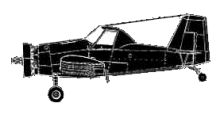
ASN Wikibase Occurrence # 385535
This information is added by users of ASN. Neither ASN nor the Flight Safety Foundation are responsible for the completeness or correctness of this information.
If you feel this information is incomplete or incorrect, you can submit corrected information.
| Date: | Friday 27 July 2001 |
| Time: | 10:00 LT |
| Type: |  Air Tractor AT-401 |
| Owner/operator: | Private |
| Registration: | N4553K |
| MSN: | 401-0809 |
| Year of manufacture: | 1991 |
| Total airframe hrs: | 1397 hours |
| Engine model: | Pratt & Whitney R1340-AN1 |
| Fatalities: | Fatalities: 0 / Occupants: 1 |
| Aircraft damage: | Minor |
| Category: | Serious incident |
| Location: | Kenesaw, NE -
 United States of America United States of America
|
| Phase: | Manoeuvring (airshow, firefighting, ag.ops.) |
| Nature: | Agricultural |
| Departure airport: | Roseland, NE |
| Investigating agency: | NTSB |
| Confidence Rating: |
The airplane sustained minor damage when it nosed over during an emergency landing following an in-flight loss of a propeller blade tip. The pilot was uninjured. The pilot stated, "While on a actual spray run the aircraft began to shake and vibrate violently. At that time I shut the power down, climbed about 100 ft to look for a place to land. The area was rolling with pasture land and a corn field in front of me, no roads to land on in the area. ... After a rolling out for a short while in corn the landing gear became stuck in corn and soft sandy soil." A portion of the remaining blade, including the separation, was shipped to the NTSB's Materials Laboratory Division. The laboratory's report stated that "a large portion of the fracture surface was on a 90-degree flat plane with multiple ratchet marks and crack arrest marks on this portion of the fracture surface. These features are typical of a fatigue crack. The fatigue crack originated from multiple origins at the bottom of a gouge on the flat face of the blade about 2.25 inches from the blade's leading edge. The fatigue crack extended through about two-thirds of the blade's cross-section. The remainder of the fracture surface (about one-third of the blade's cross section) was on a 45-degree slanted plane and was typical of an overstress region stemming from the fatigue crack." A section was saw cut from the fracture containing the fatigue origin. The paint was removed from the areas near the crack origin and the surface was re-examined with a scanning electron microscope (SEM). The gouge was measured using the SEM. The report further stated, "The length of the gouge was 0.6 inch (1.5 millimeters), and the depth of the gouge was 0.0055 inch (0.14 millimeters). ... Optical examination of the flat face of the blade near the gouge did not show any evidence of blending or rework in this area." The propeller's last overhaul was completed on January 13, 1998. The propeller accumulated 240 hours of flight since that overhaul.
Probable Cause: The propeller blade fatigue leading to its tip separating during an aerial application. Factors were no suitable terrain for an emergency landing, high vegetation, and soft terrain encountered during the emergency landing.
Accident investigation:
 |
|
Sources:
NTSB CHI01IA246
Location
Revision history:
| Date/time | Contributor | Updates |
|---|---|---|
| 04-Apr-2024 19:41 | ASN Update Bot | Added |
Corrections or additions? ... Edit this accident description
The Aviation Safety Network is an exclusive service provided by:


 ©2024 Flight Safety Foundation
©2024 Flight Safety Foundation